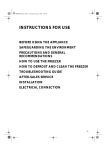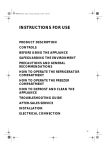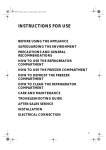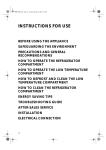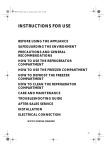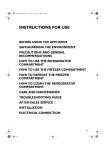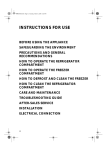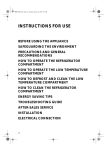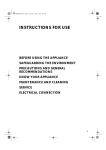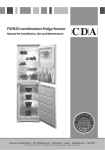Download Whirlpool AFB 820/3
Transcript
40058-gb.fm5 Page 11 Monday, October 9, 2000 5:54 PM CONTENTS GB BEFORE USING THE FREEZER PAGE 12 SAFEGUARDING THE ENVIRONMENT PAGE 12 PRECAUTIONS AND GENERAL RECOMMENDATIONS PAGE 12 HOW TO USE THE FREEZER PAGE 13 HOW TO DEFROST AND CLEAN THE FREEZER PAGE 16 TROUBLESHOOTING GUIDE PAGE 17 AFTER-SALES SERVICE PAGE 17 INSTALLATION PAGE 18 ELECTRICAL CONNECTION PAGE 19 11 40058-gb.fm5 Page 12 Monday, October 9, 2000 5:54 PM BEFORE USING THE FREEZER • Your new appliance is a freezer designed exclusively for domestic use. To get the most out of your appliance, please read the instructions carefully. These contain a description of your appliance and useful tips for storing food. Keep this handbook for future consultation. 1. After unpacking the appliance, check for damage and make sure that the doors shut properly. Any damage must be reported to your dealer within 24 hours after delivery of the appliance. 2. Wait at least two hours without moving the appliance before switching on. This will give the refrigerant circuit time to settle and operate efficiently. 3. Installation of the appliance and electrical connections must be carried out by a qualified electrician, in accordance with the manufacturer's instructions and local regulations. SAFEGUARDING THE ENVIRONMENT 1. Packing The packaging material is entirely recyclable, and marked with the recycling symbol. Follow local regulations for scrapping. Keep the packaging materials (plastic bags, polystyrene parts, etc.) out of reach of children, as they are potentially dangerous. Information: This appliance does not contain CFCs (replaced with R134a) or HFCs (replaced with R600a Isobutane). For more information, refer to the identification data plate affixed to the appliance. 2. Appliance The freezer is made of recyclable material. Disposal must be carried out in accordance with local regulations for waste disposal. Make the appliance unusable by cutting off the power cord. The appliance must be delivered to an authorised collection centre for the recovery of refrigerant gas. PRECAUTIONS AND GENERAL RECOMMENDATIONS • • • • • • • • 12 Only use the freezer for storing frozen food, freezing fresh food and making ice cubes. Do not cover or obstruct the air vents of the appliance. Do not store liquids in glass containers in the freezer compartment: danger of bursting. Do not eat ice cubes or ice lollies immediately after taking them out of the freezer: risk of “cold” burns. Do not allow children to play or hide inside the freezer: risk of becoming trapped inside and suffocating. Do not swallow the contents of the ice packs. Before servicing or cleaning the appliance, unplug it from the mains or disconnect the electrical power supply. The power cable may only be replaced by an authorised person. Declaration of conformity • This appliance is intended to come into contact with foodstuffs and conforms to D.L. 108 of 25.01.1992 (European Directive 89/109/EEC). Information Appliances with Isobutane (R600a) Isobutane is a naturally occurring, low environmental impact gas. Caution is required, however, since isobutane is flammable. Therefore, it is essential to ensure that refrigerant pipelines are not damaged. 40058-gb.fm5 Page 13 Monday, October 9, 2000 5:54 PM HOW TO USE THE FREEZER This freezer can be used to store already frozen food and to freeze fresh food. The appliance data plate indicates the amount of fresh food that can be frozen in 24 hours. The freezer operates at ambient temperatures between +10° C and +32° C. Optimal performance is obtained at temperatures between +16° C and +32° C. Switching on the freezer for the first time • • • • Freezers with door contact pin The acoustic alarm sounds if the freezer door is left open for more than 1 minute. The alarm stops when the door is closed. If the freezer door needs to be left open for more than 1 minute (e.g. to rearrange food in the drawers) the alarm can be silenced temporarily by pulling the pin (see figure). There is no need to set the freezer temperature using the thermostat because the appliance is factory set. Plug in the appliance. The green power-on indicator and the red temperature indicator leds will both light up. In some models an acoustic alarm (if supplied) will also sound after approximately 1 minute to indicate that the temperature inside the freezer is not yet sufficiently low for food storage. To silence the acoustic alarm switch the fast freeze function on; the yellow indicator led will light up. Switch the fast freeze function off again once the red led switches off. Setting the thermostat Set the freezer compartment temperature by turning the knob: 1 = Minimum freezing power 4 = Maximum freezing power Thermostat settings can vary depending on ambient temperature, on how often the door is opened, and on the amount of food to be frozen. The recommended initial thermostat setting is 2 - 3. Function of leds and acoustic alarm (if supplied) The green led indicates that the appliance is on. The red led (and in certain models the acoustic alarm) indicates that the temperature inside the appliance is not sufficiently low for storing food. This occurs: • When the appliance is switched on for the first time. • When switching on again after defrosting and cleaning the compartment. • When too much food is put in to be frozen. • When the door is not properly shut. • When there is a fault in the cooling system (see “Troubleshooting Guide”). • When the thermostat is adjusted to a higher setting (lower temperature). The yellow led indicates that the fast freeze function is in operation. When alight, it also silences the acoustic alarm (if supplied). Selection of fast freeze function To freeze the maximum amount of food possible, press the fast freeze button 24 hours before placing unfrozen food in the freezer. The maximum recommended quantity of unfrozen food is shown on the data plate inside the appliance. When putting in food to be frozen, the red indicator led may light up until the temperature inside the compartment is sufficiently low. Once the 24 hours are up, switch the fast freeze function off. 13 40058-gb.fm5 Page 14 Monday, October 9, 2000 5:54 PM HOW TO USE THE FREEZER Tips for freezing and storing fresh food Wrap and seal fresh food in: aluminium foil, cling film, watertight plastic bags, polythene containers with lids or special freezer containers. • Foodstuffs (except meat, see below) must be fresh, mature and of prime quality in order to obtain high quality frozen food. • Fresh vegetables and fruit should be frozen as soon as they are picked to maintain the full original nutritional value, consistency, colour and flavour. Some meat, especially game, should be hung before it is frozen. • Note: • Always leave hot food to cool before placing in the freezer. • Eat fully or partially defrosted foods immediately. Do not refreeze unless the food is cooked after it has thawed. Once cooked, the food can then be refrozen. Freezing and storing food • • Place food to be frozen in the two top baskets. If the freezer is to be used without the tray, arrange the ice packs on top of the food to be frozen at the front of the top basket. Important: The table alongside shows the recommended maximum storage time for frozen fresh foods. Classification of frozen foods Put the frozen foods into the drawers (baskets) and classify them. Use the storage calendar to ensure foods are used before their expiry dates. Checking frozen foods Insert a freezer thermometer between frozen packs of food to check the temperature. Placing the thermometer directly on the frozen food only gives the air temperature, which does not correspond to the actual product temperature. 14 MONTHS FOOD 40058-gb.fm5 Page 15 Monday, October 9, 2000 5:54 PM HOW TO USE THE FREEZER Advice for storing frozen food When purchasing frozen food products: • ensure that the packaging is not damaged (frozen food in damaged packaging may have deteriorated). If the package is swollen or has damp patches, it may not have been stored under optimal conditions and thawing may have already begun. • When shopping, leave frozen food purchases until last and transport the products in a thermally insulated cool bag. • Once at home, place the frozen foods immediately in the freezer. • If food has defrosted even partially, do not refreeze it. Consume within 24 hours. • Avoid subjecting foods to temperature variations. Observe the “best before” date on the package. • Always observe the storage information on the package. Removing the baskets • • Pull the baskets out as far as they come, then lift up slightly and remove. Pull the bottom basket out as far as it comes, turn it slightly to the right and then remove. Note on storage capacity Storage capacity is calculated without the tray and without the three upper baskets. For increased storage space, the freezer can also be used without the baskets, for example for freezing poultry or similar products. Making ice cubes • • • • Fill the ice cube tray 2/3 full and place it on the tray or in a basket. Use the handle of a teaspoon handle to remove ice cube trays should they stick to the bottom of the compartment. Do not use sharp or pointed instruments. Bend the ice tray slightly to remove the cubes. For aluminium trays, run water on the bottom of the tray. Note: If the freezer door does not open immediately after closing, wait a few minutes in order to allow compensation of the vacuum created. Switching off the freezer Turn the thermostat anticlockwise (towards the left) to position ●. The green appliance ON led switches off, as do all the other leds, if lit; the appliance is still connected to the mains power supply. • 15 40058-gb.fm5 Page 16 Monday, October 9, 2000 5:54 PM HOW TO DEFROST AND CLEAN THE FREEZER Before any cleaning or maintenance operation, unplug the appliance from the mains or disconnect the electrical power supply. Defrost the freezer compartment once or twice a year, or when the ice on the walls reaches a thickness of 3 mm. If possible, defrost the freezer compartment when it is nearly empty. • If there is frozen food in the freezer, switch on the fast freeze function for a few hours before defrosting in order to chill food as much as possible. • Remove the food from the freezer compartment, wrap in a newspaper and group together in a cool place or in a portable cooler. • Disconnect the freezer from the mains power supply. • Leave the freezer door open to allow the frost to melt. • Pull out the defrost water drain and place a basin underneath the outlet. • Clean the interior of the freezer compartment with a sponge and warm water and/or neutral detergent. Do not use abrasive substances. • Rinse the interior and dry thoroughly. • Close the freezer and select the fast freeze function. Place the food back in the freezer and wait several hours before deselecting the fast freeze function. Prolonged disuse • Empty the freezer. • Disconnect the freezer from the mains power supply. • Defrost and clean. • Leave the doors open to prevent formation of unpleasant odours. Door seal • Clean the door seal from time to time with water, drying thoroughly with a cloth. Never apply oil or grease. Important • Ensure the vents and grilles are unobstructed in order to allow proper circulation of air. 16 40058-gb.fm5 Page 17 Monday, October 9, 2000 5:54 PM TROUBLESHOOTING GUIDE 1. The appliance is not working properly. • Is there a power failure? • Is the plug properly inserted in the socket? • Has the fuse blown? • Is the power cord in perfect condition? • Is the thermostat set to ●? 2. Temperature inside the compartments is not low enough. • Are the doors closed properly? • Is the appliance installed near a heat source? • Is the thermostat setting correct? • Are the air circulation vents blocked? 3. Temperature inside the freezer is too low. • Is the thermostat setting correct? 4. Water collects at the bottom of the freezer. • Was the freezer cleaned properly before being switched on? • Is the appliance connected and being used properly? • Is the door shut properly? 5. The yellow, red and green leds do not light up. Perform checks for problem 1, then: Contact After-Sales Service. 6. The red led remains lit and the acoustic alarm (if supplied) sounds. Check: • Was the freezer switched on according to instructions? • Was too much food frozen at one time? • Is the door shut properly? • Is the freezer faulty? • Is the thermostat setting too high? Notes: • The front edge of the appliance may be hot. This prevents the formation of condensation and is not a defect. • Gurgling and hissing noises due to expansion in the refrigerant circuit are normal. AFTER-SALES SERVICE Before contacting After-Sales Service: 1. See if you can solve the problem yourself (see “Troubleshooting guide“). 2. Switch the appliance on again to see if the problem has been solved. If it has not, disconnect the appliance from the power supply and wait for about an hour before switching on again. 3. If the problem persists after this course of action, contact After-sales Service. Specify: • The nature of the problem. • The model. • The Service number (the number after the word SERVICE on the data plate). • Your full address. • Your telephone number and area code. Note: The direction of door opening can be changed. If this operation is performed by After-sales Service it is not covered by the warranty. 17 40058-gb.fm5 Page 18 Monday, October 9, 2000 5:54 PM INSTALLATION • • • • • Install the appliance away from heat sources. Installation in a hot environment, direct exposure to the sun or installation near heat sources (heaters, radiators, cookers) will increase power consumption and should therefore be avoided. If this is not possible, the following minimum distances must be observed: - 30 cm from coal or paraffin stoves - 3 cm from electric stoves. Install the refrigerator in a dry, well-ventilated place. Clean the interior (see “How to defrost and clean the freezer“). Fit the accessories. Check the door seal is not damaged or deformed, especially after installation or reversal of door opening. Electrical connection • • • • • Electrical connections must be made in accordance with local regulations. Voltage and power consumption are indicated on the rating plate inside the appliance. Regulations require that the appliance is earthed. The manufacturer declines all liabilities for injury to persons or animals or damage to property resulting from failure to observe these regulations. If the plug and socket are not of the same type, have the socket replaced by a qualified electrician. Do not use extension leads or adaptors. Disconnecting the appliance • 18 It must be possible to disconnect the appliance by unplugging it or by means of a two-pole switch fitted upline of the socket. 40058-gb.fm5 Page 19 Monday, October 9, 2000 5:54 PM ELECTRICAL CONNECTION For Great Britain only The wires in the mains lead are coloured in accordance with the following code: BLUE - “NEUTRAL” (“N”) BROWN - “LIVE” (“L”) GREEN AND YELLOW - “EARTH” (“E”) 1. The GREEN AND YELLOW wire must be connected to the terminal in the plug which is marked with the letter “E” or by the Earth symbol or coloured green or green and yellow. 2. The BLUE wire must be connected to the terminal which is marked with the letter “N” or coloured black. 3. The BROWN wire must be connected to the terminal which is marked with the letter “L” or coloured red. Warning - this appliance must be earthed Fuse replacement If the mains lead of this appliance is fitted with a BS 1363A 13amp fused plug, to change a fuse in this type of plug use an A.S.T.A. approved fuse to BS 1362 type and proceed as follows: 1. Remove the fuse cover (A) and fuse (B). 2. Fit replacement 13A fuse into fuse cover. 3. Refit both into plug. Important: The fuse cover must be refitted when changing a fuse and if the fuse cover is lost the plug must not be used until a correct replacement is fitted. Correct replacement are identified by the colour insert or the colour embossed in words on the base of the plug. Replacement fuse covers are available from your local electrical store. Connection to a rewirable plug If the fitted plug is not suitable for your socket outlet, then it should be cut off and disposed of in order to avoid a possible shock hazard should it be inserted into a 13A socket elsewhere. A suitable alternative plug should then be fitted to the cable. For the Republic of Ireland only The information given in respect of Great Britain will frequently apply, but a third type of plug and socket is also used, the 2-pin, side earth type. In this case, the wire which is coloured GREEN AND YELLOW must be connected to the EARTH contact, and the two wires to the two pins, irrespective of colour. The supply to the socket must be fitted with a 16 amp fuse. 19









